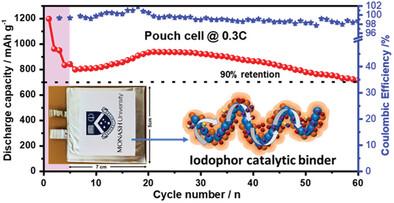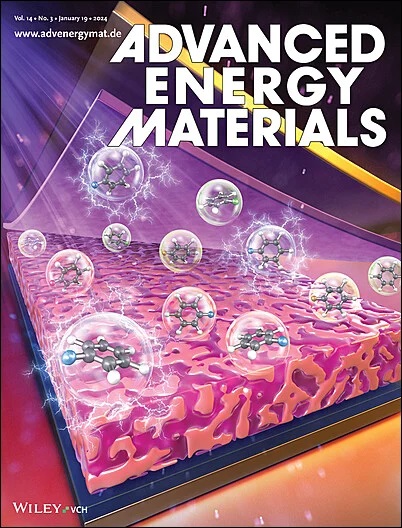聚合物碘络合物对固-液多硫化物相变和锂硫电池速率能力的影响
IF 24.4
1区 材料科学
Q1 CHEMISTRY, PHYSICAL
引用次数: 0
摘要
锂硫(Li-S)电池被认为是提供高能量电化学储能系统的可行技术。然而,由于反应动力学本身速度较慢,充放电速度较慢,限制了其在现实世界中的应用。本文报告了在电池循环过程中,聚乙烯吡咯烷酮(PVP)复杂极性网络中的聚碘化物物种在还原和氧化步骤中加速了限制速率的固液相变。密度泛函理论计算支持这样一种机制,即 PVP-碘-多硫化物复合物中多硫化物结合力的增强和附加能态的结合加速了锂-S 电池工作电压内由平衡间多碘化物反应介导的反应途径。这些研究表明,PVP-碘(PVP-I)复合物提高了电池的速率能力,在实际的 0.5C 速率下,硫负荷可提供≈7 mAh cm-2 的高单位容量。这一优势在锂-S 文献中报道的最高速率袋之一中得到了证明,在 0.1C 和 0.3C 时,能量密度分别达到 215 和 156 Wh kg。这些结果表明,分子粘合剂系统的设计发生了微妙而有力的转变,其功能作用已超出了简单地将活性材料固定在一起的作用。本文章由计算机程序翻译,如有差异,请以英文原文为准。

Role of Polymer-Iodine Complexes on Solid-Liquid Polysulfide Phase Transitions and Rate Capability of Lithium Sulfur Batteries
Lithium–sulfur (Li–S) batteries are considered as a viable technology offering energy-dense electrochemical energy storage systems. However, the inherently slow reaction kinetics manifested in the slow charge and discharge characteristics constrain their real-world applications. Here, it is reported that polyiodide species held within a complex polar network of polyvinylpyrrolidone (PVP) accelerate the rate-limiting solid-liquid phase transitions both in the reduction and oxidation steps during battery cycling. Density functional theory calculations support a mechanism in which a combination of enhanced binding of polysulfides and additional energy states in the PVP-iodine-polysulfide complexes accelerates the reaction pathways mediated by inter-valance polyiodide reactions within the working voltage of Li–S batteries. These studies show that PVP-iodine (PVP-I) complexes enhance the rate capability of cells with practical sulfur loadings delivering a high areal capacity of ≈7 mAh cm−2 at the practical 0.5C rate. This advantage is demonstrated in one of the highest-rate pouches reported in Li–S literature, attaining energy densities of 215 and 156 Wh kg at 0.1C and 0.3C, respectively. The results demonstrate a subtle but powerful shift in the design of molecular binder systems, which have functional roles above and beyond the role of simply holding the active materials together.
求助全文
通过发布文献求助,成功后即可免费获取论文全文。
去求助
来源期刊

Advanced Energy Materials
CHEMISTRY, PHYSICAL-ENERGY & FUELS
CiteScore
41.90
自引率
4.00%
发文量
889
审稿时长
1.4 months
期刊介绍:
Established in 2011, Advanced Energy Materials is an international, interdisciplinary, English-language journal that focuses on materials used in energy harvesting, conversion, and storage. It is regarded as a top-quality journal alongside Advanced Materials, Advanced Functional Materials, and Small.
With a 2022 Impact Factor of 27.8, Advanced Energy Materials is considered a prime source for the best energy-related research. The journal covers a wide range of topics in energy-related research, including organic and inorganic photovoltaics, batteries and supercapacitors, fuel cells, hydrogen generation and storage, thermoelectrics, water splitting and photocatalysis, solar fuels and thermosolar power, magnetocalorics, and piezoelectronics.
The readership of Advanced Energy Materials includes materials scientists, chemists, physicists, and engineers in both academia and industry. The journal is indexed in various databases and collections, such as Advanced Technologies & Aerospace Database, FIZ Karlsruhe, INSPEC (IET), Science Citation Index Expanded, Technology Collection, and Web of Science, among others.
 求助内容:
求助内容: 应助结果提醒方式:
应助结果提醒方式:


